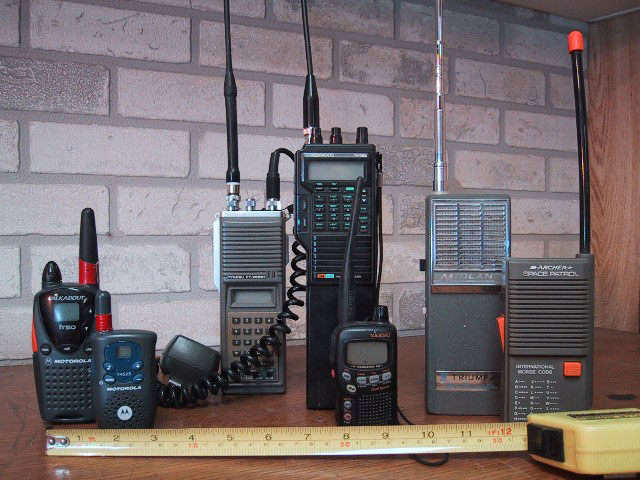Summary: Walkie talkies, in comparison to mobile phones, have their unique features, especially in one-to-one and one-to-many directional specialized communication. They excel in establishing rapid communication, particularly in one-to-many scenarios, which standard mobile phones cannot match. Walkie talkies can be categorized into eight types based on their intended use and application: Professional Walkie talkies, Commercial Walkie talkies, Civilian Walkie talkies, Amateur Walkie talkies, Intrinsically Safe Walkie talkies, Railroad Walkie talkies, Law Enforcement Walkie talkies, and Mobile Walkie talkies. Let's explore some key information about these eight types of walkie talkies.

Roles and Usage Areas of the Eight Types of Walkie talkies:
1. Professional Walkie talkies
Professional walkie talkies have a transmission power of 4-5W, with frequency ranges of 136-174MHz or 400-480MHz. They offer communication ranges of 3 to 8 kilometers (which can vary based on the specific environment). Professional walkie talkies are relatively straightforward to operate, often featuring two knobs to control channels, power, and volume. They are known for their durability, resistance to water, shock, and aging. While professional walkie talkies are bulkier and heavier, they offer stable performance and are commonly used in construction projects, property management, and factory workshops.
2. Commercial Walkie talkies
Commercial walkie talkies have a transmission power of 0.5-4W and operate within the frequency range of 400-480MHz. Communication distances typically range from 800 meters to 8 kilometers (depending on the walkie talkie's power and the environment). These walkie talkies are lightweight, aesthetically designed, and can be easily attached to the user's belt using a clip. They are often used in settings like shopping malls, supermarkets, retail businesses, factories, and manufacturing industries.
3. Civilian Walkie talkies
Civilian walkie talkies have a transmission power ranging from 0.5W to 1W and operate around the 409MHz frequency range. They offer shorter communication ranges, approximately 3 kilometers in open areas, and do not require licensing for use, as they are approved by the government as license-free wireless communication devices. Civilian walkie talkies come in compact sizes, a variety of colors, and are budget-friendly, making them suitable for personal trips, travel, and restaurant use.
4. Amateur Walkie talkies
Amateur walkie talkies, also known as "ham walkie talkies," are designed and produced for amateur walkie talkie enthusiasts to engage in personal walkie talkie activities. Various countries allocate specific frequency bands for amateur walkie talkie use. In China, these bands are located between 144-146MHz and 430-440MHz. Enthusiasts can purchase their preferred walkie talkie models, obtain local walkie talkie station licenses, and enjoy seamless communication with others who share their interest.
5. Intrinsically Safe Walkie talkies
Intrinsically safe walkie talkies are limited in terms of brands and are mainly used in hazardous environments, such as coal mines, liquefied gas filling companies, oil depots, oil fields, gas stations, chemical, petrochemical, coal mines, mining, natural gas, and chemical factories, as well as flour and flax processing plants. These walkie talkies are designed to prevent explosions and ensure safe communication in potentially dangerous locations.
6. Railroad Walkie talkies
Railroad walkie talkies are specialized communication devices tailored to the needs of the railway and railroad industry. They typically have a transmission power of 4-5W and operate within the 440-470MHz frequency range. Railroad walkie talkies feature 2-4 front-panel buttons for communication selection in different environments, such as plains and tunnels. They have high audio output requirements to ensure clear communication, especially in noisy train environments.
7. Law Enforcement Walkie talkies
Law enforcement walkie talkies are dedicated devices for the public safety and law enforcement sector. They operate within the frequency ranges of 350-370MHz and 370-390MHz. Unauthorized use of law enforcement walkie talkie frequencies is strictly prohibited. These walkie talkies offer various functions and often have keypad designs. When selecting wireless walkie talkies, it is crucial to pay attention to the transmission frequency ranges, which usually fall between 400-420MHz and 450-470MHz.
8. Mobile Walkie talkies
Mobile walkie talkies are designed for vehicular use, with a working voltage of 12.5V. Vehicles typically have two voltage standards: 12V and 24V. When mobile walkie talkies need to operate in 24V vehicles, a transformer must be installed between the vehicle and the walkie talkie. Mobile walkie talkies have a higher transmission power, ranging from 25-50W, allowing for extended signal range. However, they are fixed in one location and are commonly used in vehicle fleets.
Please note that the specifics of these walkie talkies, their features, and their usage areas may vary by brand and model, but this overview provides a general understanding of the various types and their applications.

